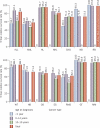Challenging issues in pediatric oncology
- PMID: 21709698
- PMCID: PMC3234106
- DOI: 10.1038/nrclinonc.2011.95
Challenging issues in pediatric oncology
Abstract
Improvements in protocol-driven clinical trials and supportive care for children and adolescents with cancer have reduced mortality rates by more than 50% over the past three decades. Overall, the 5-year survival rate for patients with pediatric cancer has increased to approximately 80%. Recognition of the biological heterogeneity within specific subtypes of cancer, the discovery of genetic lesions that drive malignant transformation and cancer progression, and improved understanding of the basis of drug resistance will undoubtedly catalyze further advances in risk-directed treatments and the development of targeted therapies, boosting the cure rates further. Emerging new treatments include novel formulations of existing chemotherapeutic agents, monoclonal antibodies against cancer-associated antigens, and molecular therapies that target genetic lesions and their associated signaling pathways. Recent findings that link pharmacogenomic variations with drug exposure, adverse effects, and efficacy should accelerate efforts to develop personalized therapy for individual patients. Finally, palliative care should be included as an essential part of cancer management to prevent and relieve the suffering and to improve the quality of life of patients and their families.
Figures


References
-
- The cancer genome census Welcome trust sanger institute [online] http://www.sanger.ac.uk/genetics/CGP/Census (XXXX)
-
- National Cancer Institute Surveillance Epidemiology and End Results. Previous Version: SEER Cancer Statistics Review, 1975–2007 [online] 2010 http://seer.cancer.gov/csr/1975_2007/ based on November 2009 SEER data submission, posted to the SEER web site.
Publication types
MeSH terms
Substances
Grants and funding
LinkOut - more resources
Full Text Sources
Other Literature Sources
Miscellaneous

